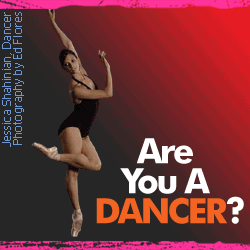Dance Review: The Aspiration of Freedom, Nederlands Dans Theater II at The Joyce Theater
April 12, 2009 by iDANZ Today
Filed under Concert Modern -Jazz-Contemporary, iDANZ Critix Corner -Dance Reviews, Reviews
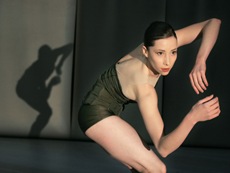 Nederlands Dans Theater II is a breath of fresh air because of the choreographic originality combined with the lack of fear exuded by each performer who graces the stage. It is interesting that one of the aspects of the company that I like so much is "lack of fear" because many of the pieces this evening tends to nudge the audience’s brain into that weird place that one fears going to where your hair stands on end.
Nederlands Dans Theater II is a breath of fresh air because of the choreographic originality combined with the lack of fear exuded by each performer who graces the stage. It is interesting that one of the aspects of the company that I like so much is "lack of fear" because many of the pieces this evening tends to nudge the audience’s brain into that weird place that one fears going to where your hair stands on end.
At the same rate that the works instill fear, they also instill laughter, curiosity and awe. My jaw is dropped throughout most of this performance because of the many emotions that each piece is stirring inside of me at once. The Nederlands choreography sends my head spinning as a result of their continued originality. Just when I think that a piece can’t possibly get any more brilliant, the dancers rise even higher than the last moment of brilliance. They continue to ride on this exponentially rising cloud of innovation all the way to the last moment of the show, which is greeted with a standing ovation and screams of praise from the entire audience.
 The show opens with a piece called Said and Done choreographed by Paul Lightfoot and Sol Léon. A pipe organ dramatically fills the air with the first chords of Johann Sebastian Bach‘s Toccato and Fugue in d-minor while the curtain rises to reveal a land of beautiful vignettes of a single man’s memories of life.
The show opens with a piece called Said and Done choreographed by Paul Lightfoot and Sol Léon. A pipe organ dramatically fills the air with the first chords of Johann Sebastian Bach‘s Toccato and Fugue in d-minor while the curtain rises to reveal a land of beautiful vignettes of a single man’s memories of life.
Among the first images are four men on stage in only black pants. The men of Nederlands II have unsurpassable technique that is coated with style and masculinity. Their virtuosity is displayed right off the bat with side extensions reaching an angle of at least 160 degrees! The mens’ bare torsos reveal every minuscule movement from the tiny twitch of a shoulder blade to a quick-breathed expanding ribcage, making these tiny movements in between their grand movements even more significant and exaggerated under the stage lights. Most of their movements are circular in this section, seeming to represent the circle of life in a man’s lifetime. Not only do they dance in circles, big and small, with the other men, but they also dance in circles around their own person as they double tour, chaînés jeté, tours jeté and perform "circular arm-ography" that includes a lot of fast circles around the face and the body with hands clasped together.
Because of the lighting, the mist on stage, the pipe organ and the white and black garb and backdrop, images of a churchyard or a graveyard come to mind. The lighting is effective in creating darkness just in front of the black curtain upstage so that when dancers walk upstage to exit, they look as though they are disappearing into the darkness or vanishing in midair like apparitions. Kudos to lighting designer Tom Bevoort.
 The three women in this piece enter though the upstage curtain like three bright white ghosts boldly appearing out of the darkness. The women move to three spots on the stage before standing still in a slight upper-back contraction as their shoulders and heads hang down to their chests. As the women stand frozen like spirits at rest, the male dancers begin to circle around the three female statues as they continue to circle each other and themselves. Impressive partnering between the males comes to a boiling point as they circle around the women. At one point, a "coffee grinder" movement on the ground happens while his partner rond de jambe en l’airs over his head, before both ending in an arabesque at precisely the same moment.
The three women in this piece enter though the upstage curtain like three bright white ghosts boldly appearing out of the darkness. The women move to three spots on the stage before standing still in a slight upper-back contraction as their shoulders and heads hang down to their chests. As the women stand frozen like spirits at rest, the male dancers begin to circle around the three female statues as they continue to circle each other and themselves. Impressive partnering between the males comes to a boiling point as they circle around the women. At one point, a "coffee grinder" movement on the ground happens while his partner rond de jambe en l’airs over his head, before both ending in an arabesque at precisely the same moment.
When the women "come alive", they are electric from head to foot. They flick a foot and a hand as if shaking off the pins and needles from being still for far too long. A long undulating movement ends in a flick of the hand and head simultaneously. Both men and women vanish into the upstage darkness, all except one man. This man dances in silence. This silence is very dramatic following the rich organ that has carried us through thus far. The silence is "pin drop" thick, and this soloist, César Faria Fernandes, fills the thick silence with a presence that is oozing with resistance in his limbs and searching in his face as black crow feathers begin to fall on him from the sky.
Lightfoot and Léon have associated black crow feathers with death as they paint a picture of a man post-mortem looking back on vignettes of his life. His memories are represented by the other dancers through duets and solos. César stands in a spotlight all the way to the right of the stage while black feathers begin to fall on him one feather at a time before falling in heaping piles. He dances with the feathers as he remains in the spotlight. He flawlessly turns, jumps and falls face first into the feathers as if to become one with them as he becomes one with death.
As César remains in the now yellow hued spotlight, the vignettes begin, danced to "The Friends’ Lament" from Capriccio sopra la lontanaza del suo fratello dilettissimo in B-Flat. Jin Young Won materializes from the blackness and shows off the prowess of her expressive legs and the emotional poignancy of her torso movements. A breathtaking moment is when Jin’s leg rond de jambes from front to side (and more and more side until it can’t go any further) as the space between her hips and ribcage continues to lengthen at the precise speed and force that her leg is moving. She is joined by a man, who assists her in displaying some very unique (and barely audible) partnering such as a turn that ends in both partners landing head to head, one on top of the other, both in plank position.
Much of the partnering in the third section of Said and Done shows how both male and female are highlighted equally instead of the "traditional" male being in the females’ shadows as he lifts and supports her. A woman steps on a man’s thigh as a prep to roll over his shoulders, and before she is finished with her movement, he begins to turn and move his body in reaction to hers. The partnering here is an impenetrable web of reacting to each others movements, not a man being as still and solid as possible in order to perform the single task of flaunting the female. Deservedly, the spotlight burns bright on both equally.
As the partnering continues, César is clearly in pain. He begins to catch the falling feathers and clutch them as if clinging to a memory. At times, he has to look away from the duets. In the end, César mimics the position of a man in the vignette in a flat back grand pléa, each man’s arms on the exact same plane in second position. Are they the same person? Nederlands II instills questions such as these in the mind that truly are the seeds of great art: deep thought.
The dancers have an incredible lightness of being as they jump, turn and partner inaudibly, which is another factor that makes them all so believable as apparitions and as embodiments of everything that has been Said and Done in this man’s lifetime. Said and Done was created in 2001 and dedicated to Hans van Manen. The dancers in this piece are Roger van der Poel, César Faria Fernandes, Anton Valdbauer, Idan Sharabi, Jin Young Won, Aram Hasier and Carolina Mancuso.
* * *
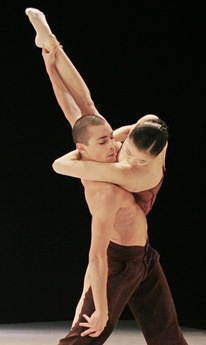 The kings of all previous ingenuity have been surpassed tonight with Jirí Kylián’s Sleepless. My jaw continues to drop and my heart continues to skip beats throughout this piece as it invokes fear and laughter simultaneously. In the program notes, Kylián goes into depth for the audience about a philosophy that "will always be [his] closest companion". . . "The nature of moving is such that if you move towards something you automatically move away from something else. Are we really clear in our intentions?" With this philosophy as his starting point, Kylián decides to explore a period of time when we are not physically moving toward or away from anything -sleep.
The kings of all previous ingenuity have been surpassed tonight with Jirí Kylián’s Sleepless. My jaw continues to drop and my heart continues to skip beats throughout this piece as it invokes fear and laughter simultaneously. In the program notes, Kylián goes into depth for the audience about a philosophy that "will always be [his] closest companion". . . "The nature of moving is such that if you move towards something you automatically move away from something else. Are we really clear in our intentions?" With this philosophy as his starting point, Kylián decides to explore a period of time when we are not physically moving toward or away from anything -sleep.
A crackling is heard. On a diagonal, four strips of marley hang perpendicular to the ground, held into place with metal poles. A lone female stands in front of a "shin buster" light in the wing downstage left. Her positioning creates a tall shadow on the marley strip closest to her. A glass harmonica begins to sing its watery, surreal song created by Dirk Haubrich based on Wolfgang Amadeus Mozart‘s Adagio in c-minor. The girl and her shadow play with one another before she gradually comes closer and closer to her shadow, at which point, her shadow becomes smaller and more dense. She puts her hands on the lip of a shadowy door. She peeks in. She gets closer to the door. The shadow door turns into a real gap that she can step into. She puts her foot and head into the black hole of nothingness, her attitude devant being the last part that is seemingly sucked into this black hole.
The marley and the lighting (Kees Tjebbes) in front and behind the panels help to create the illusion that there is nothing but blackness behind the wall. Hands pop out and frantically shake as abruptly as one of those scary moments in a movie that you would have covered your eyes for, but your eyes are forced to witness it because of its unpredictability. The music gets fast, furious and "nails on chalk-board" dissonant, when the hands uncontrollably shake making this moment seem like a persons worst nightmare in which millions of hands attack from under the bed or from an unknown place such as is created on stage this evening. The wall between reality and the unconscious world makes it seem as though everything in front and/or behind the wall is not connected at all – like a woman being cut in half by a magician.
This original composition is complemented and truly sketched out onstage with the choreography. There is a "pop" in the music, and a head pops out . There is a stunning moment when a girl flies out from the blackness behind the wall into a mans arms so quickly that it looks as if she teleported herself into his arms. Another wonderful moment that is filled with the magic of being terrifying and funny at the same time, is when a girl reaches hands first behind one strip, and a pair of hands come out the other side stretching in the same diagonal, about 4 feet up higher. The audience laughs at this illusion that she has been elongated many feet. When she submerges her whole body behind the wall, it appears as though she is flying like superman as the stretched out arms continue to reach on the other side.
The imaginative world that Jirí Kylián creates behind the wall is a terrifying, yet curious one. This must be how Alice before Wonderland felt. The partnering behind the wall must be intense and intricate, but to the audience, it looks as though the dancers are floating behind the wall as if they are in outer-space where gravity doesn’t exist. At certain points, a girl’s legs will come out from each side of the strip toward the top of the wall, meaning that she must be on a person’s shoulders back there performing this feat. Limbs come out of the darkness and then quickly get drawn back in like a snail back into its shell or a snake’s slithery tongue quickly retracting. In one instance, a dancer’s head gets sucked into the darkness while her body remains outside. Her body shakes and writhes as if she is seeing something horrible "on the other side".
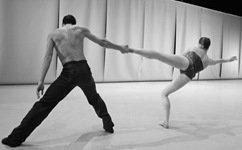 The partnering in Sleepless is as unique as some of the most phantasmagorical dreams that a person could have. The women wear colored leotards that match the men’s pants, greens, reds, blues. The lights often change to a shade of blue when the partnering evokes a deep sea dream as the man effortlessly lifts the girl by holding onto her ankle in arabesque, making her float above him as if through water. The frantic, "nails on chalk board" sound revisits the dream when the couple turns the focus to their hands, which flop and hit together faster than seems possible. When the horrible sound ends, the couple returns to the flowing dream sequence. These abrupt U-turns that are made from the most terrifying to the most peaceful point in a dream cause the audience to be on the edge of their seat with their hair raised!
The partnering in Sleepless is as unique as some of the most phantasmagorical dreams that a person could have. The women wear colored leotards that match the men’s pants, greens, reds, blues. The lights often change to a shade of blue when the partnering evokes a deep sea dream as the man effortlessly lifts the girl by holding onto her ankle in arabesque, making her float above him as if through water. The frantic, "nails on chalk board" sound revisits the dream when the couple turns the focus to their hands, which flop and hit together faster than seems possible. When the horrible sound ends, the couple returns to the flowing dream sequence. These abrupt U-turns that are made from the most terrifying to the most peaceful point in a dream cause the audience to be on the edge of their seat with their hair raised!
The dancers who duet and react to and embody the sounds of this dream/nightmare, accompanied always by the eerie glass harmonica, are Carolina Mancuso, Maud de la Purification, Jin Young Won, Anton Valdbauer, Menghan Lou and Roger Van der Poel. There are moments of soft, fast human whispers coming from all different directions. A heavy thunderstorm follows. The "nails on chalkboard" moments continue to explode like firecrackers at random moments. Sleepless concludes in the same way it begins. A girl’s shadow becoming smaller and smaller, until she slips through the door leading to darkness and dreams, except this time, she is slipping through the door to bring her back to reality or to the conscious world-or is she doing just that? "Are we really clear in our intentions?…Are we really sure that we want to move towards or away from…?
* * *
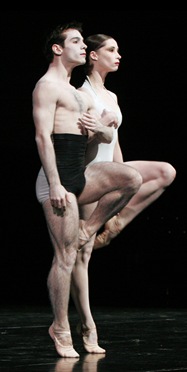 The text of a Gertrude Stein’s poem, "If I told Him: A Complete Portrait of Picasso", is painted on stage in front of us in Shutters Shut as the text is mixed up and mashed in the style of a most virtuosic disc jockey… or a Picasso painting. This particular dj, Gertrude Stein, is the sole serenader of a man and a woman gradually making their way from stage right to stage left as they paint in a Picasso fashion every nuance of a poem with their bodies as conceived by Paul Lightfoot and Sol Léon.
The text of a Gertrude Stein’s poem, "If I told Him: A Complete Portrait of Picasso", is painted on stage in front of us in Shutters Shut as the text is mixed up and mashed in the style of a most virtuosic disc jockey… or a Picasso painting. This particular dj, Gertrude Stein, is the sole serenader of a man and a woman gradually making their way from stage right to stage left as they paint in a Picasso fashion every nuance of a poem with their bodies as conceived by Paul Lightfoot and Sol Léon.
The first line of the poem is introduced by a stiff- lipped girl, Carolina Mancuso. Dressed in a white leotard with limbs and face powdered just as white, begins moving with isolated, exaggerated hip, hand and head movements to the opening lines of the poem:
If I told him would he like it. Would he like it if I told him. Would he like it would Napoleon would Napoleon would would he like it. If Napoleon if I told him if I told him if Napoleon. Would he like it if I told him if I told him if Napoleon.
Words get repeated. Sentences get repeated. There is a moment of silence in which her mouth goes from lips tightly pressed together to a gaping open mouth that creates a red blotch on her otherwise white body. These factors emphasize the oddity and modernism of this piece. This is yet another example of Nederlands Dance Theatre II as dance pioneers in the world of the absurd.
Idan Sharabi quickly jumps out of the downstage right wing, donning the same powdered white skin as Carolina, but donning contrasting black shorts that come up to just below his ribcage. They both quickly do 180s to reveal his all white back-half of costume and her all black back-half of costume. They use this yin and yang striking contrast to emphasize certain syllables and accents in the poem as they quickly turn back to front and front to back.
Shutters shut and open so do queens. Shutters shut and shutters and so shutters shut and shutters and so and so shutters and so shutters shut and so shutters shut and shutters and so.
A two dimensional painting is created in the way that both dancers stay on the same plane throughout the entire piece as they move from one side of the stage to the other. Their white limbs create traces in the air as they depict a certain phrase or word, a phrase or word whose sound sends corresponding trails through the air.
To exact resemblance the exact resemblance as exact as a resemblance, exactly as resembling, exactly resembling, exactly in resemblance exactly a resemblance, exactly and resemblance. For this is so. Because.
Lightfoot and Léon along with lighting designer Tom Bevoort create porcelain, marionettes onstage as they move in isolated, disjointed movements to paint the poem. Stein’s poem is the puppet master, the dancers only movements coming from a syllabic string tug to the left, right, up or down. In Shutters Shut, the collaboration of text, choreography and performance is absolutely unparalleled.
* * *
The final piece of the evening, Sad Case, makes the men and women of a vintage photograph come alive. Although, when these characters come to life, they are raunchy, not exactly what one would expect of these Chaplinesque beach characters as they dance over-exaggerated, eccentric moves to Muchachita and Maria Bonita (Perez Prado), Frenesi (Dominguez), Always in my heart (E. Lecuona), Watusi (Ray Barretto) and Peridia (Los Tres Panchos). Bryan Arias, Menghan Lou, César Fernandes, Carolina Mancuso and Vania Vaz dance a dance of the unexpected, which I am starting to expect at this point in the show!
Extreme high spirits (to say the least) possess each dancer at different points in the piece that take shape in outbursts of loud laughter with mouths as wide open as they could possibly be. In the program notes, Paul Lightfoot attributes the maniacal laughter and exaggerated emotions to the high hormones and emotions of Sol Léon’s pregnancy that she was deep into at the time of the piece’s conception (no pun intended). This state of affairs must have been the "seed" for the emphasis on the males’ "male-ness" throughout the entire piece. The crotch area of the men is highlighted throughout with exaggerated pelvic thrusts and even bold "crotch-grabbing".
 Sad Case brings to life the quote "A woman without a man is like a fish without a bicycle"-
Sad Case brings to life the quote "A woman without a man is like a fish without a bicycle"-
Gloria Steinman. This quote printed in the program notes brings to light the feminist point of view, "we don’t need ’em." Why? Well, once again, Lightfoot and Léon explore absurdism with eccentric dance moves that make the men and the women not flow together organically, and literally butt heads. They tend to not use opposition whatsoever, and in our culture, and well, in science, opposites attract, so there isn’t a lot of attraction between the two sexes here.
Their heads roll side to side in the same direction as their steps, which are exaggerated greatly as the arms stay glued to the sides of the body. These movements are reminiscent of the teachings of Betsy Baytos, who is the current choreographer of the Vaudeville Cirque Du Soleil show coming to New York City in 2009 and has dedicated a good portion of her life to teaching the eccentric dance moves of Ray Bolger, Dick Van Dycke, Marilyn Miller and Joe Brown to people and corporations such as Disney, where she works on animation choreography.
All of the dancers have white powder all over their bodies. The women wear sea-green leotards, and the men wear sea green underwear/corsets that come up to right below their ribcages, illustrating a faded photograph of beach-goers in the 30’s. But, before any dancers arrive on stage as their antique -selves, there is a "bit" with the lights much in line with a Max in the Flight of the Navigator movie.
There are two sets of lights, one downstage and one upstage, that hang from the catwalk in an upside down "v" on long, black poles. While these lights look at one each other as the music begins, they appear as though they are having a conversation as they gradually move together. The unusual lighting once again comes from Tom Bevoort, and this "light-ography" brilliantly sets the stage for the comedic piece that ensues.
The piece begins with one girl coming through the upstage curtain and awkwardly passing through the lights that are almost perpendicular to the ground by this point. Then, she starts the awkward walk downstage as her pushed-forward hips lead the way for every step forward. This awkwardness in movement is a breath of fresh air with all of its eccentricities! The awkwardness and maniacal tension continues as two men walk the "catwalk" the lights have created with mouths wide open as they laugh loudly and crazily. One doesn’t know whether to be amused or scared.
The lights remain alive with a sense of humor throughout the piece. There are "cat-call whistles" in the music, and it seems as though the lights are the ones cat-calling to the male and female dancers. This choreography just has no boundaries. Many of the moves resemble the way you dance as a three year old child to your favorite cartoon theme song, except Lightfoot and Léon’s choreography puts a layer of sex on the whole "frolicking innocence" with a concentration on the pelvic region. At times, the crotch is what starts the movement. For example, a man grabs his crotch, pushes it forward and moves forward as if dragged by a rope that has been tied between his legs.
The dancers form a straight line as they gradually rotate, in true Rockette-fashion, 90 degrees at a time. This line becomes the home base for all of the raving, pelvic thrusting eccentric dancers before they step "out of the line" to solo or duet, which might include a dance move that looks a lot like a velociraptor impression. As they laugh, speak jibber and move like Jim Carey comedians and comediennes, I think, ‘how beautiful’. The quirky choreography and idiosyncratic personalities Nederlands Dance Theatre II engenders is a gift of liberation for the world of dance, whether it be modern, ballet or music theatre.
The piece ends with a man spread eagle on his back, which is arched up, and his head downstage staring at the audience. The lights all come down to highlight his crotch. A little egocentric? We definitely get the point.
* * *
Nederlands Dance Theatre II has an understanding of the fusion of music and dance that is totally groundbreaking. I have never seen such intimacy between music and dance without the musical compositions imprisoning the choreography or the dancers. All that I see here is freedom in movement, in expression, in voice and in character, each virtue being a universal aspiration, making this company an inspiration for us all. Oh, and this is the apprentice company? When is the parent company coming to town?
All Photos @Joris-Jon Bos Photography
iDANZ Critix Corner
Official Dance Review by Adrienne Jean Fisher
Performance: Nederlands Dans Theater II
Choreography: Jirí Kylián and Paul Lightfoot/Sol Léon
Venue: The Joyce Theater, New York City
Date:Thursday, April 9th, 2009, 8:00 PM
www.iDANZOnline.com
Click Here To Become a Member of iDANZ Today!
iDANZ – The Social Network Where Dancers Live!

